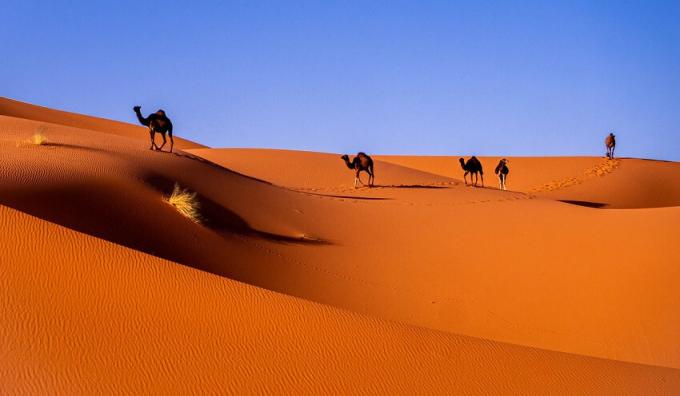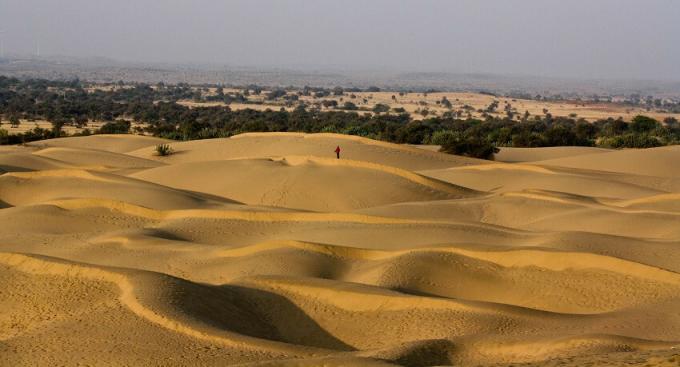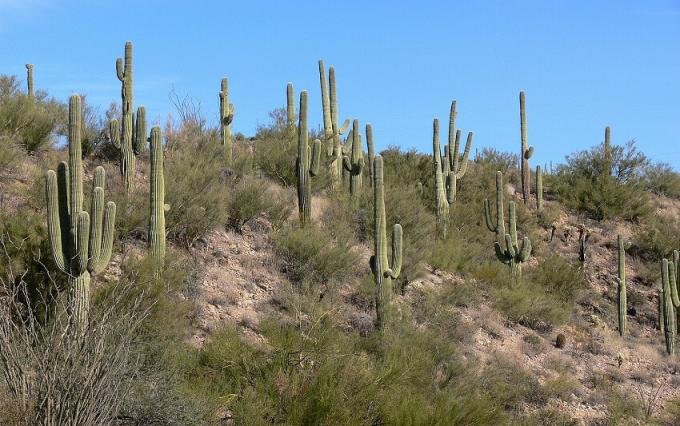The 11 types of desert, and their characteristics
One third of the earth's surface is made up of deserts, but none of them is the same. There are many types of deserts and, contrary to what one might think, not all of them are limited to being a place where the sun shines down and the heat drowns us.
There are tropical, dry and sandy deserts such as the Sahara, but there are also landscapes with little life full of ice, frost and darkness such as Greenland. Whether they are cold or warm, all of them are characterized by having little rainfall, which conditions the forms of life that inhabit them.
Next We will know the different types of desert that there are, its climatic characteristics and some species that can be found in them.
- Related article: "The 8 types of biomes that exist in the world"
The types of desert, classified and explained
When we see the word "desert" the first image that comes to mind for the vast majority is the Sahara: an extensive place of dune landscape, full of sand and without vegetation. This African desert has become the prototype of what we know as a desert and, in fact, its name comes from the Arabic "aṣ-Ṣaḥrāʾ al-Kubrā" which literally means "the Great Desert".
This is why any landscape that resembles the Sahara in one way or another is easily identified as a desert: the Atacama, Australia, a large part of the United States... However, It is not the heat or having a landscape made of sand that makes a territory be considered a desert, but how much rain falls on it. For this reason, it should not surprise us that places like Greenland, that great island-continent made practically of ice, qualify as a desert, in fact, one of the largest.
Before discussing desert types in more depth, it is necessary to understand exactly what they are. Deserts are one of the 15 biomes that exist on earth, that is, they are sets of ecosystems and these are characterized by having less than 225 millimeters of annual rainfall. As they are places where it rains little, these territories are dry areas, which completely conditions the development of life, although it does not mean that no living organism inhabits it.
There is little diversity of organisms and, in fact, there is little organic matter, few nutrients and, generally, very few plant and animal species.. The few species that live there are highly adapted to life in the desert, be it cold or hot, and on many occasions we find extremophile species. They can withstand very difficult living conditions such as water scarcity and extreme temperatures, and there may be very high values, above 40ºC, or very low values, below -40ºC.
Having understood what deserts are, it is time to get down to business and discover what types of desert exist. As we said, there are not only warm ones, as the Sahara would be, but there are also cold ones and they can present other distinctive peculiarities.
1. tropical deserts
We start with the prototypical deserts. tropical deserts are those ecosystems that are located near the terrestrial equator. Most of the known deserts and, being close to the equatorial strip, receive a large amount of solar radiation, which makes them very hot places.
These deserts are formed because of the winds present at these heights, the trade winds, preventing the formation of clouds and preventing rain. Combined with the extreme heat, these places are very dry and can well exceed 55ºC, depending on the time of year.
The Sahara desert is the typical tropical desert, and so are the Syrian-Arabian desert, which It is practically the eastern continuation of the great North African desert, the Thar desert and the Kalahari. Part of the Australian desert would also fall into this category.

2. polar deserts
Polar deserts are places where it rains little, have few plant and animal species, and are large flat plains, just like tropical deserts. They are alike in many ways except one: its highest temperature per year does not exceed 10ºC. In fact, the average temperature in these places is -20ºC and it can be below -40ºC. It is very cold.
As the temperature is lower than the freezing point of water, in these places we do not find dunes of sand as in the Sahara, but huge and extensive ice sheets where it is difficult for plants to grow some. Examples of this are Greenland and Antarctica, with ice sheets 2 km thick.

- You may be interested in: "The 6 types of ecosystems: the different habitats we find on Earth"
3. Cold or mountain deserts
Cold or mountain deserts are those that, as their name suggests, They form at high altitudes, where ecosystems are located in places with very low temperatures, low pressure, little oxygen, and little rainfall..
This causes that in some areas of the mountains plateaus are formed where life is composed mostly of lichens. Some deserts of this type are found in Tibet, Patagonia, the Andes and some areas on the periphery of the Arctic.
4. monsoon deserts
Although the word "Monzón" makes us think of torrential rains, the truth is that monsoon deserts are like the others, dry and arid, but they are related to this weather event. These deserts are not formed in the monsoon areas, but in the coastal areas of the Indian Ocean as a result of the trade winds carry rainfall to inland areas and discharge there, far away, leaving the coast without rain some. The Rajasthan desert is a case in point.

5. coastal deserts
Coastal deserts are found on the western edges of the continents that lie at the Tropics of Cancer and Capricorn.. Despite being close to the coast, they receive the impact of cold ocean currents which, together with the presence of the trade winds, causes a situation of atmospheric stability to be maintained that prevents precipitation from occurring, which translates into a lot of barrenness.
In these places it is very rare that it rains. In fact, on average it rains only once every 5 or 20 years depending on the place. However, fog may appear that somewhat mitigates the lack of water and, in places where it is more present, the The ground is completely sodden, causing some grasslands to thrive and the occasional tree, cacti and lichens. These mists are equivalent to about 600 mm of "normal" rain.
Some examples of these deserts are found in the coastal part of Western Sahara, Namibia, Australia and the desert between Chile and Peru.
6. Mid-latitude continental deserts
These deserts occupy vast areas that go from central Asia, in Mongolia and China to Turkmenistan and the shores of the Caspian Sea. Examples of them are the Gobi, the Taklamakan and the Karakum, as well as the deserts of Iran, Iraq and Syria. We can also consider deserts of this type those of the western United States and those of Australia.
The Asian mid-latitude continental deserts have summer rainfall and a very strong temperature range.. In summer they are warm places, with temperatures close to 25ºC, but winters are dry and harsh, dominated by the Siberian anticyclone and with temperatures below zero for several months followed.

7. subtropical deserts
Subtropical deserts are located near the equator, but are not impacted by the trade winds. They are areas with high atmospheric pressure that are far from the oceans and seas, so they receive little rain. In part, the Sonoran desert could be considered a subtropical desert, although it can also be said that North American deserts have some peculiar features that we will see below.
8. North American deserts
North America is a very large region, large enough to have its own set of deserts. Although its deserts have typical characteristics of the tropics and those of mid-latitudes, those that extend between the southwestern United States.UU. and central Mexico have some very interesting characteristics that make them stand out from the rest.
These include hyper-arid zones with almost no vegetation but, together, removing salt flats and dune fields, its biomass is much higher compared to the rest of deserts. They are places where complex and highly diversified ecosystems are located.
The most characteristic is that of Sonora, which has extensive vegetation, especially in the form of cacti of all kinds, heights, and colors. One of its most distinctive cacti is the sahuaro (giant carnegiea), which can measure 15 meters in height and can live up to 200 years. The flowers of this plant open at night so as not to be exposed to excessive heat and its main structure reserves large amounts of water.

9. barrier deserts
Barrier deserts form in regions that are surrounded by large, high mountain ranges. The mountains act as barriers, preventing the entry of wind and clouds loaded with precipitation., making them dry places not because of the heat or the extreme radiation of the sun, but because they are deprived of rain. An example of this type is the Judean desert in Israel.
10. australian deserts
The case of the Australian deserts also deserves special attention, since in that continent there are no there are extreme deserts and their arid areas, from a climatic point of view, are rather limited. In fact, the territory receives rainfall between 150 and 400 mm per year, which means that In many desert places, the rule that they must be places with little rain is not complied with..
However, these rains are extremely irregular and can provide a lot, in a ratio of 1 to 10. This means that a lot of vegetation can grow in a specific place because it has started to rain with frequently, but at a given moment there is no more rainfall, causing all the fertile ground to dry out for complete. Ecosystems change a lot and the only vegetation that is assured of survival is the extreme.
The Australian outback is very dry, so dry that a major fire occurs almost every year, fires produced thousands of years ago by the natives and, since the modern Australian has settled, the new settlers. These fires kill the weakest plants to fire, but favor the growth of pyrophytic and xerophytic plants that resist it very well. The most characteristic vegetation is the mulga (Acacia aneura) and some eucalyptus.

11. alien deserts
Alien deserts? What do they paint here? Taking into account the main characteristics of deserts, dry places, without precipitation, with extreme temperatures and little life, the landscapes of other worlds fall within of this group. Any planets that have winds and have a solid surface have deserts, with Mars being the closest to our world..
Alien deserts strictly comply with the characteristic of not having life. Well, at least as far as we know, there is no life on Mars, and this can be used for future research on the red planet since this world would serve to simulate how life would develop on other planets that, so far, have not been "invaded" by organisms some.
Bibliographic references:
- Manrubia, S.C. (2012) “Astrobiology: In search of the limits of life”. CSIC-INTA.
- Mucina, L. (2019) “Biome: evolution of a crucial ecological and biogeographical concept”. New Phytologist.
- Gurera, D., Bhushan, B. (2020) “Passive water harvesting by desert plants and animals: lessons from nature”. Philosophical Transactions of The Royal Society A Mathematical Physical and Engineering Sciences.
- Alcaraz Ariza, F.J. (2012) "Deserts and semi-deserts". University of Murcia.

